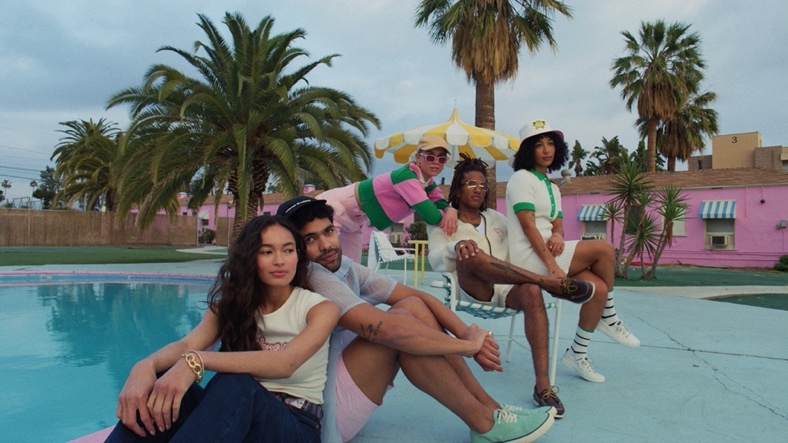Statistics about the importance of brand purpose and its impact on purchasing behavior abound in the marketing industry. Here’s one: 66 percent of online respondents would consider a company’s purpose when deciding to make a purchase, according to Porter Novelli’s 2021 Purpose Perception Study And the numbers increase when considering trust, loyalty and even forgiving a company if it slips up.
So, when Elizabeth Drori joined as CMO of Sperry footwear last November, she begin establishing a purpose platform—grounded in its 87-year history—designed to break through beyond the boat shoe. Following is our conversation with Drori about the evolution of the Sperry brand, fashion merchandising strategies tapped from her Walmart days, how the company uses data from product launches to optimize consumer messaging, and more.
Chief Marketer: For your new “Make Waves” brand campaign, who is the target audience and what are the strategic marketing goals?
Elizabeth Drori, CMO of Sperry: We launched our brand campaign “Make Waves” with the goal of driving brand awareness and desire for Sperry. It’s the first time in a few years that we’re really investing behind the brand and not just product stories. It speaks to a lot of what we stand for, but it’s also a rallying cry for our consumers and encourages people to make the most of every moment, make your own path, make a difference. From a targeting perspective, we’re serving it to households ages 18 to 34.
CM: Is this target a shift for you?
ED: It’s a shift from where our current customer is. We had this audience 10 years ago and now we’re looking to get there again. Brands often reach a cycle where they have a target audience and they grow with that audience. And now that audience is the next generation and you need to reach a younger consumer again. That’s where we are. Our current customers are a bit older, so we’re looking to drive that resonance with younger consumers in the next generation today.
CM: How are you accomplishing that through specific channels?
ED: From the media standpoint, the brand campaign is running on YouTube, for the demographic targets we talked about, as well as interest segments. But then we also market on other channels that resonate. We have been experimenting on TikTok. We do a lot on Instagram. We use influencer marketing.
CM: How are you evolving the brand to recruit those younger consumers once again?
ED: We’re doing a few things differently. First we updated our visual look and feel, which ranges from modernizing our logo, which we refreshed at the beginning of the year, to colors, fonts, the topography as well as styling. We’re trying to portray a younger, more fashion-forward audience just through our creatives and how you visualize the brand, no matter of the channel. We’re also partnering with brands and people of influence. As I mentioned, we work with influencers and style leaders.
We’re also doing a lot of product collaborations. One example is a collaboration with Warm and Wonderful, which is the British brand known for the sheep sweater Princess Diana made famous. That collaboration’s coming up later this summer; we shot a campaign with them and Madelaine Petsch of “Riverdale.” We have some of that creative out in the marketplace right now. And then finally, investing in the brand through the Make Waves campaign and also through a new purpose platform that we call “All for water, water for all.” We’re trying to create a desirable brand by making it more purpose-driven and more of a lifestyle brand.
CM: What are the challenges of marketing to a younger audience with a brand that has an 87-year history? How do you tap into its history while also refreshing it for new customers?
ED: Sperry has an incredible heritage and backstory. We were founded by Paul Sperry who had a passion for sailing and yet a problem with slipping on boat decks. Our story is that he noticed one winter day how easily his dog was able to walk across an icy pond without slipping, and after looking at the groves in his paws, he decided to invent boat shoes and sneakers that have those grooves cut out as traction. We have this powerful story, and it is still the foundation of our brand in terms of being innovators, adventurous, explorers.
We’re a brand that gets passed down from generation to generation, so we have a lot to build on. How do we stay close to our roots, but then make the brand feel relevant for today? This story gives us is a connection to the water. We’ve done a lot of research and exploration on what an association with the water means for consumers today. How do we unlock that power of water and harness the joy and associated emotional well being to the water for consumers today?
The second aspect of it is our role in fashion. Post-World War II, Sperry became known for an association with nautical, preppy-style. JFK wore us, Paul Newman wore us. We have these amazing associations, but we still need to modernize how to stay relevant in fashion and culture today. What’s wonderful for us is that preppy fashion is returning in a more modern aesthetic–more diverse, more open… we’re trying to hone in on that. How do we take this amazing legacy and focus on what it means to be connected to the water, and how do we unlock that? And then how do we continue to lean into the preppy trend in a way that feels current?
CM: You’ve had experience launching new brands at Walmart in the past. What did you learn that you’re applying at Sperry?
ED: At Walmart, we were focused on building fashion credibility. We had a strategy that we called “borrowing fashion credibility.” You can advertise yourself, but it’s even more impactful when other people talk about your brand and your product. At Walmart, we leaned heavily on influencers and content partners to change perception. At Sperry, to the extent that people perceive the brand as something only for the elite, there’s still a perception challenge to address. We’re leaning into partners and influencers in a similar way.
And then we’re also paying very careful attention to how we show up. We want to portray the brand in a relatable, youthful, approachable way, but we still love the water. We’re optimistic. We seek adventure. We don’t take ourselves too seriously. We’ve done a lot to portray ourselves as a much more open and democratic brand, and then also leaning into partners to drive that fashion credibility.
CM: How has Sperry’s brand purpose evolved?
ED: I mentioned that we have a new brand purpose platform, “All for water, water for all.” Before I got to the brand, we didn’t have a purpose platform. We were doing some things in the sustainability space. We supported the LGBTQ+ community, but we didn’t have anything that tied all that we were doing together. This platform was meant to create a purpose-driven strategy that’s grounded in our heritage. “All for water” is the sustainability piece. Water is the world’s biggest playground. How do we ensure we protect it? We have really great goals: By 2024, we want half of what we produce to be made from primarily recycled materials. We have a collection that we call “SeaCycled.” That’s growing more and more, and we’re very close to achieving that goal.
We work with Waterkeeper Alliance, which is the world’s largest nonprofit dedicated to clean and drinkable water. We’re doing a lot with them this year and making the sustainability piece a bigger part of our brand. And then “water for all” is something we’re activating this year. It shapes our vision for a world where everyone, everywhere, has access to the water and feels welcome there. When we came up with this platform, we started digging into some of the reasons why people of color don’t have access to water. It’s complicated. They’ve been excluded because of discrimination. There’s fear that dates back to slavery. There are socioeconomic factors. There’s so many reasons.
What we started to learn is that the solve is very grassroots. There isn’t one national or global organization that’s doing anything here. So we partnered with a media organization to create documentaries telling stories of entrepreneurs that are making a difference in the space in their own way and in their own communities. We’re starting to roll that content out this summer and will look to amplify their stories, and we’re really excited about having this conversation, learning ourselves, and then having that conversation more publicly later this summer.
CM: How does Sperry use data to achieve marketing goals?
ED: One of the biggest ways is through our product launches. We are launching new products regularly and we use data to assess their performance. We’ll track data that we get from Sperry.com to understand if we’re bringing in a new consumer. And if it’s an existing consumer, what are they cross-shopping? What’s their demographic information? And then we’ll also be tracking how fast product is selling through across all points of market, whether it’s Sperry.com or through our wholesale partners. Those pieces of information give us a solid feedback loop for how we can optimize our advertising and how to lean into what’s working and understand for future launches.
CM: Lastly, what are some marketing trends that the industry should be watching right now?
ED: One, for fashion in particular, continues to be influencer marketing. We see that evolve as new channels like TikTok come up and content changes. It’s an important validation mechanism and it can also drive sales. And it requires a lot of test-and-learn. There’s really no one-size-fits-all approach. The metaverse and everything that’s happening there is also a trend that people need to pay attention to and figure out if there’s a way in or not.






